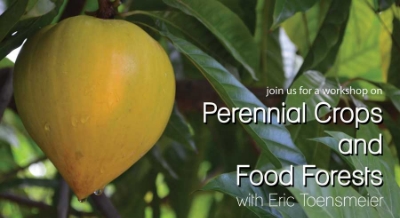
Today 8 hours of my day were spent at ECHO attending a class on Permaculture and touring the farm. The promo for the class I attended is below.

ECHO is an organization aimed at fighting world hunger. To that end they have simulated growing conditions of the different regions of the world where hunger is an issue. Each of the regions is set up and attended by interns who will later go out into the world and teach what they learn on the farm. They have areas to simulate growing conditions on steep slopes, jungle conditions and even an urban setting. All of them are designed to promote efficiency of food production in smaller areas and to allow them to be maintained without the use of commercial fertilizers and modern equipment. The plants grown provide not only food for the humans who will be tending them but also fodder for animals, herbal medicines, building materials and soil amendments.Clean, safe water is also addressed in he building of wells water catching systems and purification methods. ECHO does so much more that this post is barely scratching the surface.
The whole day was impressive! The speaker Eric Toensmeier was an articulate, funny and a man who possesses a wealth of knowledge on the subject matter. He broke down the basic concepts of permaculture and explained with examples that were easily understood by normal non permaculture experts. There were over 100 people from all over South Florida listening intently and taking notes on the wealth of information coming at everyone.
What you don't know what permaculture is? That is ok, until a few months ago I did not have a formal understanding of the topic. Think of the classic three sisters, corn, beans and squash. That is permaculture at its easiest and finest. Corn provides the support for the beans and the squash cover the ground below acting as a living ground cover. All three support each other as well. The beans are nitrogen fixer for the corn and squash. The squash protects to ground and prevents erosion while cooling the earth below.
Permaculture focuses on perennial plants and companion planting to improve yields and build soil. One of the methods of soil fertility I had the opportunity to learn about was biochar. This link will take you to a great source of information on biochar as I can not even begin to describe it and it's benefits in this page.
http://www.biochar-international.org/biochar
Unfortunately, biochar requires an airtight kiln to properly burn the wood to make high quality biochar. I can't see our neighborhood association going for this. Maybe someday.
Permaculture, however, is perfect for our climate and has been utilized in most tropical climates for centuries. While at ECHO I purchased a cranberry hibiscus and lemongrass. The lemongrass will provide a fragrant mulch for my beds and the hibiscus will provide both food and tea. If we do not like it it will be purely decoration as it is a lovely plant.
I will keep you posted on the permaculture journey!
:)
